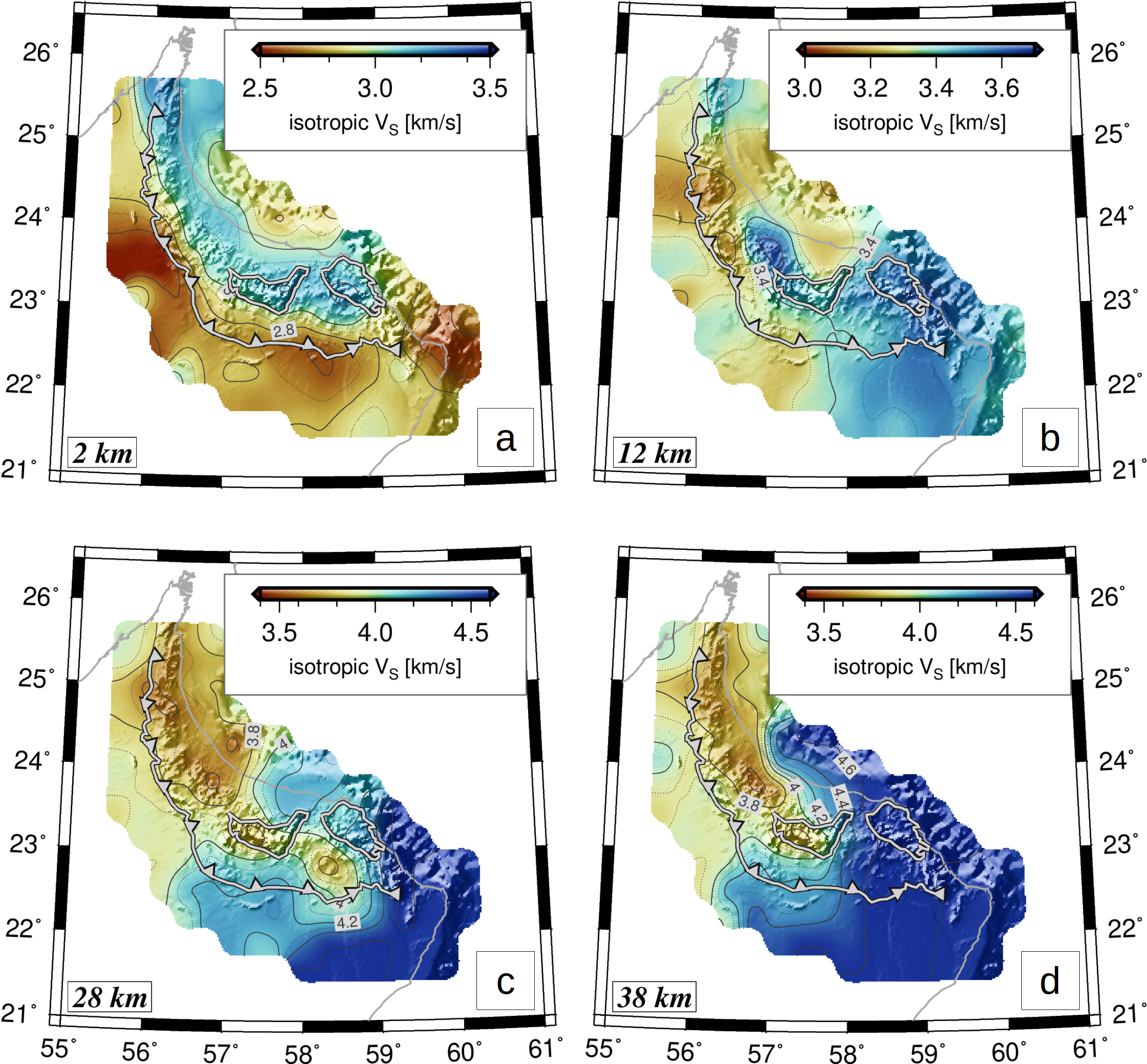Summary
ORLA2022 is a radially anisotropic crustal shear wave velocity model, parameterized in terms of isotropic S velocity (Voigt average) and the radial anisotropy RAD [Vsh-Vsv; km/s]. ORLA stands for “Oman Rayleigh-Love Ambient Noise” based velocity model.
Quicklinks
Description
| Name | ORLA2022 |
| Title | A 3-D crustal shear wave velocity model and Moho map below the Semail Ophiolite, eastern Arabia |
| Type | 3-D Isotropic and Radially Anisotropic Shear Wave Velocity Model |
| Sub Type | S-wave velocity (km/s) and Radial Anisotropy (km/s) |
| Year | 2022 |
| Data Revision | r0.0 (revision history) |
| Short Description | ORLA2022 is a radially anisotropic crustal shear wave velocity model, parameterized in terms of isotropic S velocity (Voigt average) and the radial anisotropy RAD [Vsh-Vsv; km/s]. ORLA stands for “Oman Rayleigh-Love Ambient Noise” based velocity model. |
| Authors: | Lars Wiesenberg, Christian Weidle, and Thomas Meier: Institute of Geosciences, Christian‐Albrechts‐Universität zu Kiel, Kiel, Germany Amr El-Sharkawy, Institute of Geosciences, Christian‐Albrechts‐Universität zu Kiel, Kiel, Germany National Research Institute of Astronomy and Geophysics (NRIAG), Helwan, Cairo, Egypt Frank Krüger, University of Potsdam, Institute of Geosciences, Karl-Liebknecht-Str. 24-25, 14476 Potsdam, Germany Andreas Scharf, Department of Earth Sciences, College of Science, Sultan Qaboos University, PO Box 36, PC 123, Al-Khod, Muscat, Sultanate of Oman Phillippe Agard, Sorbonne Université, CNRS-INSU, Institut des Sciences de la Terre Paris, ISTeP UMR 7193, 75005 Paris, France |
| Reference Model | None |
| Model Download | ORLA2022.r0.0.nc (see metadata) is the ORLA2022 model in netCDF 3 Classic format. |
| Model Home Page | https://www.seismologie.ifg.uni-kiel.de/go/orla2022 |
| Depth Coverage | Crustal depths (0-41km) |
| Area | Eastern Arabian Continental Margin, Oman (latitudes: 21.5°N/25.5°N, longitudes: 55.5°E/60°E) |
| Data Set Description | ORLA2022 is based on Rayleigh and Love wave phase velocity dispersion measurements using ambient seismic noise which were inverted for radially anisotropic shear wave velocity over depth. Phase velocity dispersion curves were calculated from continuous data from the temporary Cool seismic network (Weidle, et al., 2013) and eighteen local permanent stations from the Oman Earthquake Monitoring Centre, the Dubai seismic network and the Global Seismographic Network. |

Citations and DOIs
To cite the original work behind this Earth model:
- C Weidle, L Wiesenberg, A El-Sharkawy, F Krüger, A Scharf, P Agard, T Meier, A 3-D crustal shear wave velocity model and Moho map below the Semail Ophiolite, eastern Arabia, Geophysical Journal International, Volume 231, Issue 2, November 2022, Pages 817–834, https://doi.org/10.1093/gji/ggac223
To cite IRIS DMC Data Products effort:
- Trabant, C., A. R. Hutko, M. Bahavar, R. Karstens, T. Ahern, and R. Aster (2012), Data Products at the IRIS DMC: Stepping Stones for Research and Other Applications, Seismological Research Letters, 83(5), 846–854, https://doi.org/10.1785/0220120032.
DOI for this EMC webpage:
https://doi.org/10.17611/dp/emc.2022.mecmus.1
References
- Weidle, C., Agard, P., Meier, T., Ducassou, C. & El-Hussain, I., 2013. Cool (crust of the oman ophiolite and its lithosphere) seismic network, GEOFON Data Archive , https://doi.org/10.7914/SN/5H 2013
Credits
- r0.0 model provided by Lars Wiesenberg.
Revision History
revision r0.0: uploaded November 16, 2022.






